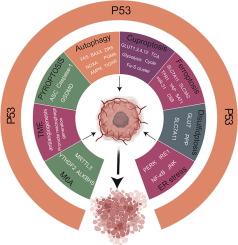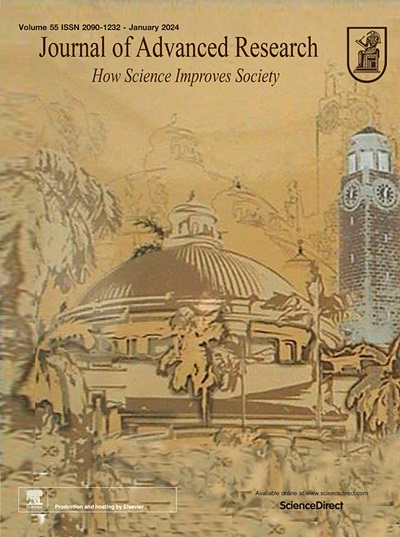p53 在癌症发展中的多重作用:调节肿瘤微环境、m6A 修饰和多种细胞死亡机制
IF 11.4
1区 综合性期刊
Q1 MULTIDISCIPLINARY SCIENCES
引用次数: 0
摘要
背景由人类癌症中最常见的突变基因 TP53 编码的蛋白 p53 在抑制肿瘤方面具有多种功能。作为最著名的转录因子,p53 可调控细胞的各种基本反应,包括细胞周期停滞、DNA 修复、衰老以及细胞程序性死亡(PCD),其中包括自噬、细胞凋亡、铁凋亡、杯凋亡、热凋亡和二硫化亡。越来越多的证据表明,肿瘤微环境(TME)、N6-甲基腺苷(m6A)修饰和多种 PCD 对癌症的进展、增殖和转移具有重要作用。m6A是真核生物RNA中最普遍、最丰富的内源性修饰,在多种生物学过程中发挥着至关重要的作用,其中包括癌症的进展。此外,PCD 是一种进化保守的细胞自杀机制,也是生物体内的常见过程。某些形式的 PCD 会导致癌症的发生和发展。然而,人们对 p53 在 TME 中的复杂作用、m6A 修饰和多种 PCD 机制仍不完全了解。目前,我们总结了 p53 的功能作用,包括野生型和突变型 p53 在不同情况下的功能作用。此外,还讨论了癌症免疫、癌细胞死亡和 RNA m6A 甲基化之间的相互作用,以及 p53 在癌症发生和发展过程中的调控。此外,还探讨了 p53 参与调控 TME、m6A 和多种 PCD 的关键分子机制。所有这些发现将有助于开发新的治疗方法。本文章由计算机程序翻译,如有差异,请以英文原文为准。

Multiple roles of p53 in cancer development: Regulation of tumor microenvironment, m6A modification and diverse cell death mechanisms
Background
The protein p53, encoded by the most frequently mutated gene TP53 in human cancers, has diverse functions in tumor suppression. As a best known transcription factor, p53 can regulate various fundamental cellular responses, ranging from the cell-cycle arrest, DNA repair, senescence to the programmed cell death (PCD), which includes autophagy, apoptosis, ferroptosis, cuproptosis, pyroptosis and disulfidoptosis. Accumulating evidence has indicated that the tumor microenvironment (TME), N6-methyladenosine (m6A) modification and diverse PCD are important for the progression, proliferation and metastases of cancers.Aim of review
This paper aims to systematically and comprehensively summarize the multiple roles of p53 in the development of cancers from the regulation of TME, m6A Modification and diverse PCD.Key scientific concepts of review
TME, a crucial local homeostasis environment, influences every step of tumorigenesis and metastasis. m6A, the most prevalent and abundant endogenous modification in eukaryotic RNAs, plays an essential role in various biological processes, containing the progression of cancers. Additionally, PCD is an evolutionarily conserved mechanism of cell suicide and a common process in living organisms. Some forms of PCD contribute to the occurrence and development of cancer. However, the complex roles of p53 within the TME, m6A modification and diverse PCD mechanisms are still not completely understood. Presently, the function roles of p53 including the wild-type and mutant p53 in different context are summarized. Additionally, the interaction between the cancer immunity, cancer cell death and RNA m6A methylation and the p53 regulation during the development and progress of cancers were discussed. Moreover, the key molecular mechanisms by which p53 participates in the regulation of TME, m6A and diverse PCD are also explored. All the findings will facilitate the development of novel therapeutic approaches.求助全文
通过发布文献求助,成功后即可免费获取论文全文。
去求助
来源期刊

Journal of Advanced Research
Multidisciplinary-Multidisciplinary
CiteScore
21.60
自引率
0.90%
发文量
280
审稿时长
12 weeks
期刊介绍:
Journal of Advanced Research (J. Adv. Res.) is an applied/natural sciences, peer-reviewed journal that focuses on interdisciplinary research. The journal aims to contribute to applied research and knowledge worldwide through the publication of original and high-quality research articles in the fields of Medicine, Pharmaceutical Sciences, Dentistry, Physical Therapy, Veterinary Medicine, and Basic and Biological Sciences.
The following abstracting and indexing services cover the Journal of Advanced Research: PubMed/Medline, Essential Science Indicators, Web of Science, Scopus, PubMed Central, PubMed, Science Citation Index Expanded, Directory of Open Access Journals (DOAJ), and INSPEC.
 求助内容:
求助内容: 应助结果提醒方式:
应助结果提醒方式:


